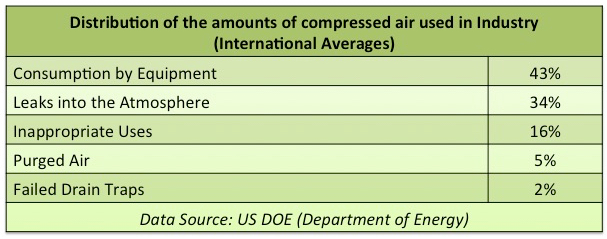Energy Saving in Compressed Air Systems for Manufacturing
The Ugly Expensive Truth About Compressed Air
It takes about 8 hp of electrical energy to produce 1-hp-worth of work with compressed air. Typical losses associated with producing and Distributing compressed air. Assuming 100 HP energy input, approximately 91 HP ends up as losses, and only 9 HP as useful work.
- The Compressed Air is the most expensive Engineered utility within a manufacturing plant & the most overlooked energy waste
- The Compressed Air System is an easy & economical area to carry out energy saving yet produces very significant savings
The costs that contribute in running a compressed air system are determined by various elements. Some of the pertinent questions manufacturers have to ask themselves about the compressed air system are:
- Are the individuals who are involved in producing & consuming the compressed air have a basic understanding of its cost and significance?
- Are the compressor controls the most suitable in managing how & when compressors cycle & if they are networked correctly?
- Does the compressed air system have all the necessary auxiliary components to ensure that Clean, Dry Compressed air is produced with the right temperature (Uncontaminated)?
- Is the compressed air system piped accurately starting from the compressors themselves down to the end uses?
- Are the discharge pressure, system pressure and operating pressure in the entire network where it should be?
- How much is the system leaking, contributing to artificial demand that overworks compressors?
The energy losses from a compressed air system is a combination of causes that can arise such as compressor controls, incomplete or inadequate auxiliary components such as an after cooler, dryer, correctly sized receiver tanks, intake filtration, ambient conditions, piping, over pressurization, faulty uses, misuses and finally, compressed air leaks. A simple leak elimination activity alone can eliminate up to 20% of compressed air costs. A comprehensive plant wide audit to first identify, locate and eliminate air leaks can be further followed through by tackling all other causes of energy loss in the compressed air system. The result of the audit should provide a manufacturer with information of energy losses, causes, measurements, data analysis, costs, improvement and prevention.
Preventive Maintenance should be further strengthened with Predictive Maintenance
A 0.8mm size air leak @ 6bar pressure costs a manufacturer over RM700 per year & that same size leak at 8bar will cost approximately over RM4000 per year Out of the 100% compressed air produced by the compressors, only 43% is consumed by the end uses known as ACTUAL DEMAND. A whopping 57% of the produced compressed air is wasted via various means & the bulk of it is leaked into the atmosphere. This is also known as ARTIFICIAL DEMAND 
Most of the time, compressed air leaks are ignored or overlooked because it cannot be
On average, 20% to 30% of a manufacturer’s energy cost is taken up by compressed air. In some industries where the consumption of compressed air is heavier, it can be as high as 40%.
IN SHORT, COMPRESSRED AIR IS VERY EXPENSIVE TO PRODUCE & CONSUME but at the same time it is also very
INEXPENSIVE TO OPTIMIZE & SAVE
It is time your organization invests in a Compressed Air System Audit and eliminate Energy Waste
3 key elements to consider in the costs of compressed air
Many times, the focus on the cost of compressed air is only at the compressor level. This leads to many mistakes in terms of determining the energy saving cost parameters. When looking at the compressed air system. It is important to focus on 3 key elements:
- The cost from generating & distributing compressed air
- The cost from consuming compressed air at the auxiliary stages and at end uses (Actual Demand)
- The cost from wasting or leaking compressed air throughout the network (Artificial Demand)
Compressed air leaks can cause a string of consequences. Most people only view compressed air leaks as just air leaking but in reality it can cause severe problems such as:
- Moisture migration, oil & other particles that can contaminate the system
- Turbulence from leaks can cause rise in temperature that results in weakened system pressure causing compressors to unnecessarily work
- Cumulative turbulence from wrong piping can also cause back pressure which can cause mechanical stress on the compressors & premature loading & unloading
- A contaminated system can also cause internal piping diameters to be compromised resulting in frictional losses to pressure
- Leaks can impact the functioning of receiver tanks, dryers, filters, moisture separators & other auxiliary equipment at the facility level
- Incorrect pressure setting at regulators at the end uses from upstream & downstream leaks engages compressors unnecessarily.
- The maintenance & repair costs on older compressors & the stress on newer compressors just does not make any financial sense in allowing compressed air leaks
These are just some of the many implications of a system mired in compressed air issues. A well-structured energy management system should be in place to address these issues. Energy saving initiatives in compressed air system is quite simple, straightforward, economical & best of all results in very significant savings. A simple leak elimination project alone can reduce between 10% to 20% of total compressed air costs. A compressed air system audit will significantly enhance an existing energy management program in a manufacturing plant. If there isn’t a dedicated EM program, the compressed air system is a fantastic place to start. There is a misconception that when it comes to energy efficiency or energy waste, it is the sole ownership of Facilities or Engineering. This is a misconception that can only be dispelled by creating awareness. The compressed air is an engineered utility but a shared utility. The Facilities(SUPPLIERS) produce & distribute CDA to the Production who are the (DEMANDERS). Any kind of demand from the production side, be it actual or artificial, facilities can only see it as actual demand. An energy saving program not only creates the avenue for energy saving but establishes the understanding that the shared utility is a shared responsibility between facilities & production that will lead to a balance in power generation & consumption.



